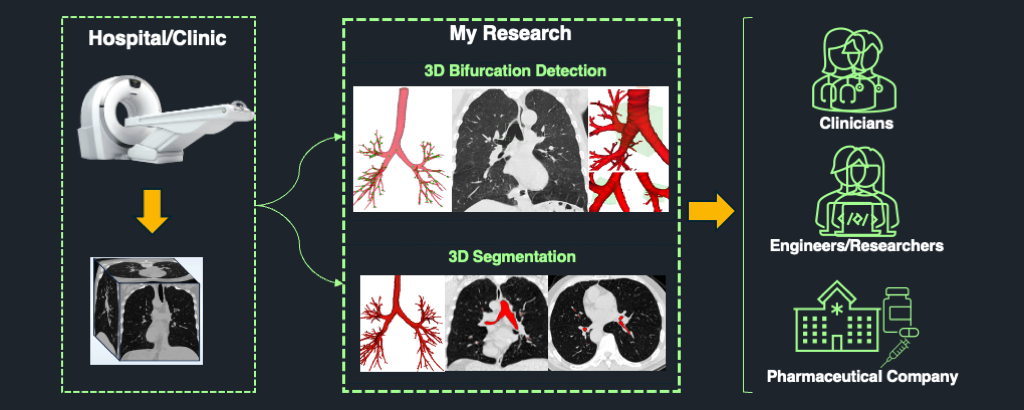5 months research project on Tubular Structures Enhancements
Hello, 
Hello! I’m a Ph.D. candidate in Artificial Intelligence and Computer Vision, with a focus on medical imaging. I hold an M.S. in Data Science and AI and a B.S. in Software Engineering. My research interests include deep learning, domain adaptation, loss function regularization, few-shot learning, and 3D model analysis.
Currently, I’m investigating domain adaptation, novel bifurcation detection methods, and topology-preserving loss functions to improve the analysis of tubular structures in medical images.
On-going Projects and Publications: LINK
News
Jan, 2025: Our work on “Curriculum Learning for Few-Shot Domain Adaptation in CT-based Airway Tree Segmentation” got accepted to 22nd IEEE International Symposium on Biomedical Imaging (ISBI 2025), Houston, TX, USA.
Nov. 2024: My master’s student, Maxime Jacovella (co-supervised with Prof. Angelini) graduated with distinction from Imperial College London and received the prestigious Winton Capital Prize.
Nov. 2024: Excited to share our new paper on incremental domain adaptation in airway segmentation, now available on arXiv: LINK .
Nov. 2024: I Received (again!) BME Conference Fellowship from Engineering for Health Interdisciplinary Center (E4H) of IP-Paris.
May. 2024: I received a Travel Grant to attend the 2024 IEEE International Symposium on Biomedical Imaging (ISBI 2024).
March 2024: I got accepted to CIFAR Deep Learning + Reinforcement Learning (DLRL) Summer School, Co-hosted by CIFAR and the Vector Institute in Toronto, Ontario, Canada.
Feb. 2024: My work on few-shot airway-tree modeling got accepted to 21st IEEE International Symposium on Biomedical Imaging (ISBI 2024), Athens, Greece.
Jul. 2023: I Received BME Conference Fellowship from Engineering for Health Interdisciplinary Center (E4H) of IP-Paris.
Jul. 2023: I received Best Poster Award from Engineering for Health Annual Forum.

5 months research internship on strategic machine learning model maintenance in CEDAR (Inria Saclay) team.
Member of the mobile development team for developing, deploying, and maintaining new Android Applications.
I worked on the complete software development pipeline from defining requirements to testing and deployment.
Ph.D. in Artificial Intelligence (on-going)
- Thesis: 3D modeling of thin tubular structures in lungs using deep learning on large-scale medical cohorts
- Research Domain: deep learning, computer vision, medical imaging, respiratory health, lung digital twin
-
Python
-
Java
-
SQL
-
Persian
-
English
-
French
-
PyTorch95%
-
PyTorch Lightning80%
-
Monai95%
-
OpenCV75%
-
Numpy95%
-
Scikit-learn90%
-
Machine Learning
-
Computer Vision
-
Research
-
Linear Algebra
-
Statistics & Probability
-
Multivariate Calculus
-
Optimization
-
Software Engineering
-
Databases
-
Version Control (Git/GitHub)
-
Android Development
-
Cardiovascular Anatomy

1. Bifurcation Modeling
Since April 2023
I am developing novel methods for detecting and analyzing bifurcations in both airways and arteries within thoracic CT scans, aiming to improve disease understanding and treatment planning. This project includes creating and releasing BifDet, the first public dataset for 3D airway bifurcation detection.
- Keshavarzi, A., Bouniot, Q., Smith, B. M., & Angelini, E. (2024). “BifDet: A 3D Bifurcation Detection Dataset for Airway-Tree Modeling”, Under Review for NeurIPS 2024.
2. Tubular Structures Segmentation
Since Nov. 2022
I am focusing on incorporating prior knowledge and loss function regularization techniques into deep learning models to achieve topologically correct predictions for tubular structures like airways and arteries in lung CT scans. This research aims to improve the accuracy and reliability of segmentation results for these critical anatomical structures.
- Keshavarzi, A., & Angelini, E. (2024). “Few-Shot Airway-Tree Modeling using Data-Driven Sparse Priors”, 21st IEEE International Symposium on Biomedical Imaging (ISBI). Athens, Greece. LINK
- Jacovella, M., Keshavarzi, A., & Angelini, E. (2024). “Curriculum Learning for Few-Shot Domain Adaptation in CT-based Airway Tree Segmentation”. LINK
3. Anatomical-Tree Modeling
Since May. 2024
Building upon the BifDet dataset, I am developing comprehensive airway and arterial tree models to advance our understanding of respiratory and cardiovascular health. This research aims to provide detailed insights into the morphology and bifurcation parameters of both systems, potentially informing personalized treatment strategies.
- Address: Paris, France
- Email: name.lastname@ip-paris.fr
- Phone: X
- Internship Available

